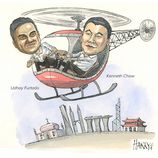Proving value
South Korean chemical company LG Chem’s record-setting US$2bn exchangeable bond showcased the depth of the equity-linked market and its value as an alternative fundraising channel amid rising interest rates.
LG Chem, an investment-grade issuer, is a regular in the US dollar bond market, but had not visited the equity-linked market since 2018. As US dollar rates rose, an EB issue looked attractive.
The deal also offered LG Chem a way to monetise a 1.57% stake in LG Energy at a premium amid volatile markets, instead of selling the shares via a block trade at a wide discount.
The dual tranche EB offering launched in July is the largest international EB ever in Asia Pacific and the biggest equity-linked transaction from South Korea.
The deal comprised a US$1bn five-year put-two EB (due 2028) and a US$1bn seven-year put-four EB (due 2030) to smooth out LG Chem’s debt maturity. The two tranches targeted different investors within the equity-linked market, creating price tensions to maximise demand and improve pricing.
The 2028 tranche was marketed at a coupon and yield-to-maturity of 0.75%–1.25% and an exchange premium of 25% to LG Energy’s closing price of W550,000 on July 11. It was priced at a 1.25% coupon.
The 2030 tranche was marketed at a coupon and yield-to-maturity of 1.35%–1.85% and an exchange premium of 30% to the July 11 close. It was priced at a 1.60% coupon.
The deal locked in a low financing cost for LG Chem compared with its straight bonds. For instance, the 1.25% coupon of the five-year put-two EB offered around 475bp annual savings compared with LG Chem’s US dollar bond due in July 2025 which traded at close to a 6% yield prior to the EB pricing day.
Investors liked the deal as it was a sizable offering from a top-tier issuer that offered diversification from China, with a liquid underlying stock that is one of the world’s largest electric vehicle battery makers.
The EB drew tremendous demand, with investors from all over the world putting in more than US$10bn of orders during the five-hour bookbuilding.
The 2028 tranche attracted over US$6bn from 150 investors, with 30% allocated to Asian investors, 28% to Europe and 42% to the US. The 2030 tranche drew over US$4bn from 130 investors, with 26% allocated to Asian investors, 43% to Europe and 31% to the US.
To facilitate hedging for the deal and reduce the impact on LG Energy’s shares the next day, the leads also arranged a delta placement of about US$360m.
Shares in LG Chem closed down 0.2% at W653,000 on July 12, while LG Energy’s shares dropped 2.9% to W534,000. The 2028 and 2030 EBs traded above their issue prices at 101.85–102.20 and 101.10–101.45 respectively.
Citigroup, Goldman Sachs and HSBC were the joint global coordinators and joint bookrunners.
To see the digital version of this report, please click here
To purchase printed copies or a PDF, please email shahid.hamid@lseg.com











